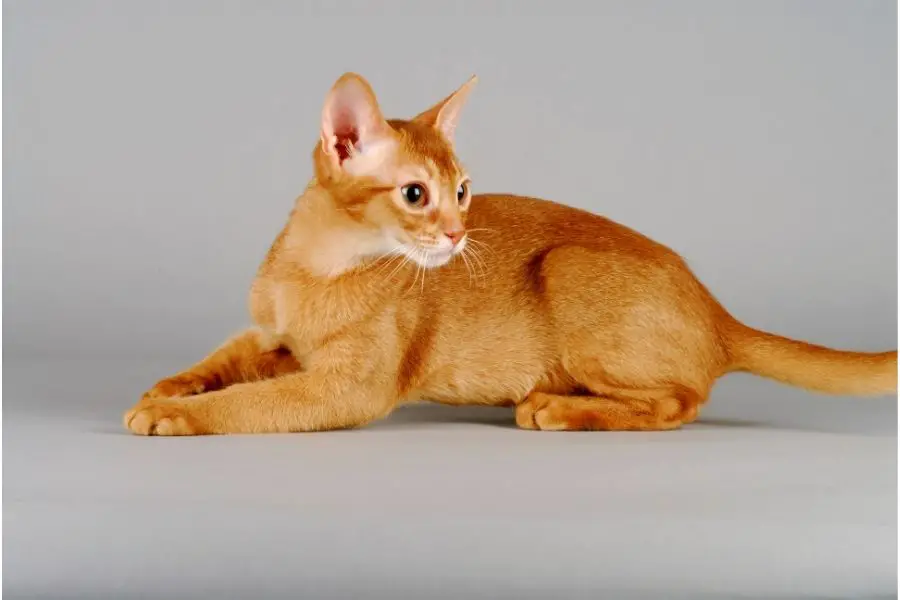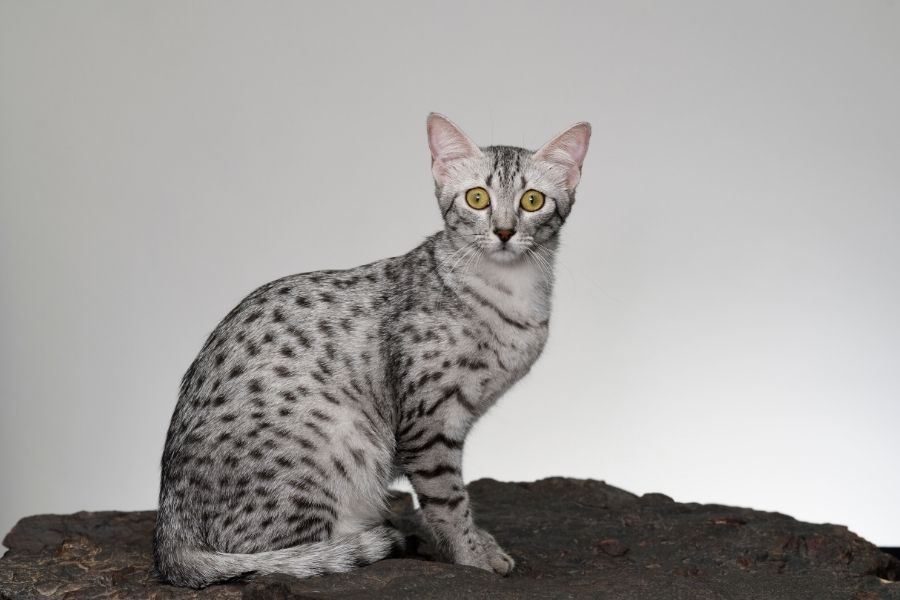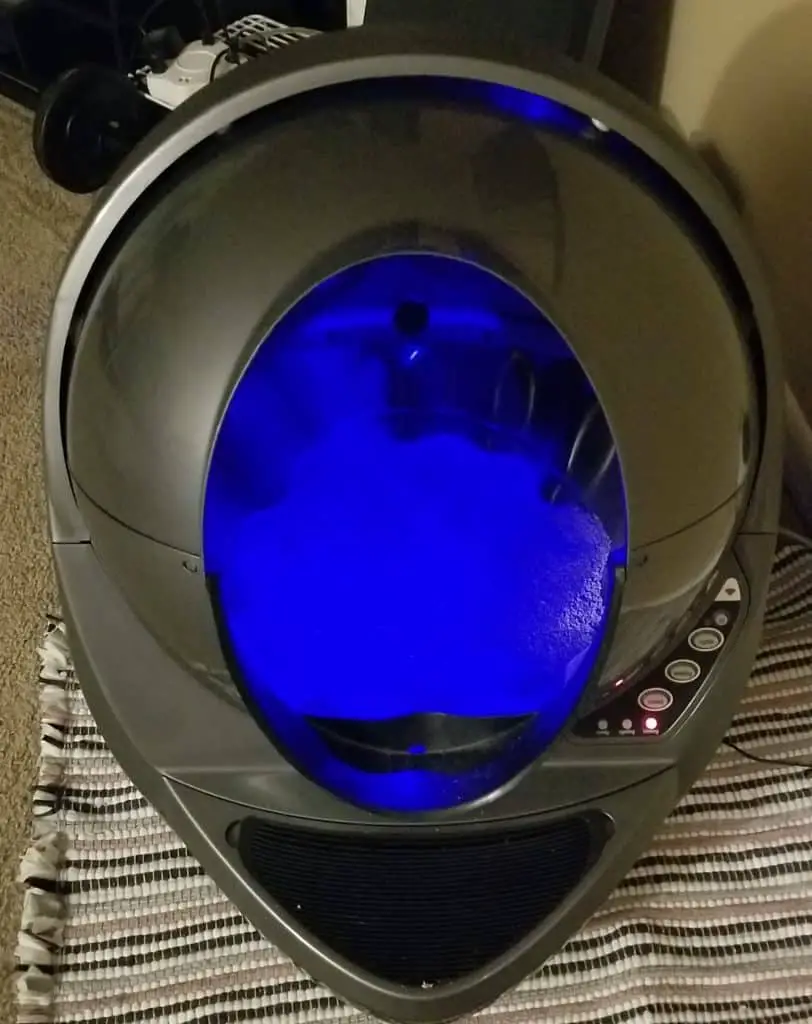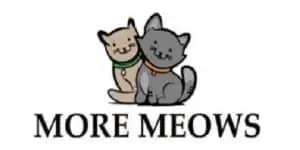More Meows is an Amazon Associate. As an Amazon Associate we earn from qualifying purchases. We may also earn commissions if you purchase products from other retailers after clicking on a link from our site.
Africa is a wonderful continent that captivates anyone who spends time there. I have been to the African continent many times over the years and treasure the experiences I’ve had there. So when thinking about Africa and which cats are the best, I immediately start thinking of four cats in particular.
The 4 Best African cat breeds (African domestic cats) are:
- Savannah Cat
- Abyssinian Cat
- Somali Cat
- Egyptian Mau
| Best African Cat Breeds | Reason |
| Savannah Cat | Large, playful, and acrobatic. |
| Abyssinian Cat | Intelligent, playful, and entertaining. Somali CatRambunctious, fun-loving, friendly to strangers. |
| Egyptian Mau | Playful, active, and fast. |
Pro-Tip: If you are thinking of buying a cat or are a cat owner already, then you should be aware that taking care of the litter box can be a real chore. In this age of smart products, an automatic litter box has been created that actually makes life easier with taking care of the litter box. If you want to make your life much easier with a litter box that means you’ll never have to scoop litter again, check out the best automatic litter box on the market (in my opinion) on Amazon.
Read on to learn more about the four best African domestic cats!
Savannah Cat
Savannah Cat Origin
This striking, exotic-looking hybrid breed is the result of crossing a Siamese cat with a wild African Serval. The outcome is a long-legged, athletic cat that is both highly intelligent and affectionate. It also looks as if it belongs on the plains of the Serengeti.
The first Savannah cat was bred in 1986. The parents were a male African Serval and a female domestic cat. It took a few decades for the breed to develop and become stabilized. Today, these cats are one of the most desirable breeds in the world.
Savannah cats were recognized as an official breed in 2001 by The International Cat Association (TICA). As a hybrid breed, kittens are available as F1, F2, F3, F4, et cetera. The closer they are to an F1 hybrid, the more wildness they retain in their looks and personality.
An F1 or F2 hybrid is larger, with more distinctive spotted coat markings. In addition, their behavior is often less friendly and docile than F3 or F4 crosses.
Savannah Cat Features
Savannahs have spotted markings, like African Serval. The colors range from brown and black to silver, gray, cinnamon, and less commonly, blue, chocolate, and seal.
Savannah Cat Size
Medium to large in size, Savannahs look tall and leggy. However, the tallest cat in the world, declared by the Guinness Book of World Records, is a 19-inch-tall Savannah cat.
Generally, males reach around 17 inches tall and between 20 and 25 pounds. Females are smaller in stature, growing to 14-15 inches tall, weighing 12-15 pounds.
Their long legs and muscular bodies make them athletic and agile. Savannahs can jump 8 feet into the air! They are very active cats. Expect to see them jump up onto the fridge and every other high-up surface in the house.
To learn more about Savannah cats, check out this article: Are Savannah Cats Easy To Train? Revealing Info!
They have large triangular ears that sit upright on their heads and unusual, hooded eyes that have a piercing gaze. In addition, Savannahs have thick, relatively short tails and long, slender necks, which add to their wild appearance.
Savannah Cat Personality
They are curious, adventurous, and playful cats. Many people describe them as being more like a dog than a cat. They can easily be leash trained and go for walks with you. Savannah cats enjoy the water and will even swim!
An amazing characteristic of the Savannah cat is its intelligence. They can teach themselves how to open doors, flush toilets, turn on faucets. For fun, they study the law of gravity by pushing objects off of shelves and counters to observe what happens.
You can channel this intelligence by training your Savannah to do tricks, like acrobatic jumps. Play with them using interactive toys and puzzles to provide mental stimulation. They respond well to positive reinforcement, so give them lots of treats during training.
Their personality always charms people who have never met Savannah cats before. They tend to instantly become avid fans of the breed after meeting one!
Savannah Cat Behavior
Savannah cats are high in energy, so they need to be exercised daily to keep them out of mischief. Provide them with a tall cat tree, or get them a playful cat-friendly canine companion.
They do not cope well with being left at home on their own all day. They tend to have a high prey drive, are territorial, and are wary of strangers.
Savannahs make fantastic family pets. They bond with humans and animals that they see every day and are ideal companions for kids. They can even join your family for hikes and other outdoor activities.
We talked about how Savannahs make good family pets but do they need company? Check out this article: Do Savannah Cats Need Company? The Wild Answers.
Abyssinian Cat
Abyssinian Cat Origin

The Abyssinian (or Aby, as they are often called) is a breed thought to originate from Ethiopia. The Abyssinian cat is an ancient cat breed. Mummified cats that bear a striking resemblance to Abyssinians have been found in ancient Egyptian tombs.
While the precise origin of the breed is uncertain, the modern Abyssinian breed was developed and refined in Britain in the 1900s, but it existed long before. It was first recognized as a breed by TICA in 1979. They played a key role in feline veterinary science as the first cat to have their DNA genome sequenced in 2007.
Abyssinian Cat Appearance
Abyssinian cats are most commonly russet, cinnamon, or copper-red. They have also been bred to have blue, fawn, and silver coats. Their fur is very fine in texture. Each hair is delicately ticked with dark and light bands. Thus, their hair gives them a unique, almost iridescent-looking coat.
Their ears are large, broad, and set atop their head as if they are alert and listening. They have a pointed muzzle, deeply expressive, almond-shaped eyes with green or gold irises.
Abyssinian Cat Size
Aby cats are built like ballerinas – they have svelte proportions but are also muscular and athletic. As a result, they often look like they are trotting around on their tiptoes with long graceful legs, a long, tapering tail, and compact little paws.
They are medium-sized felines. According to TICA, female Abys reach 6 to 9 pounds, while males are slightly larger, reaching 7-12 pounds.
Abyssinian Cat Personality
These cats have big personalities. They are full of energy, curious, and playful. Abys are class clowns that seek out play and attention from their owners. They are highly entertaining to watch as they get the zoomies or pounce and swipe at imaginary butterflies.
Abyssinian cats are people-oriented and make devoted companions. They are generally very loving towards their owners and love spending time at their side.
However, they are usually not fond of too much cuddling or hands-on attention. Instead, they love following you around the house, sitting next to you, and making their unique chirruping vocalizations at you.
The Abyssinian may not be the ideal breed for a family with young children, as they will avoid the grabby hands of toddlers.
Abyssinian Cat Health Issues
Overall, the Abyssinian cat breed has few health issues, and their lifespan is 14 to 17 years, with many living into their 20s. However, instead of slowing down in their golden years, Abys tend to keep their kitten-like disposition throughout their lives.
Reputable Abyssinian cat breeders test for hereditary diseases like PK-Def (Pyruvate Kinase Deficiency, a form of anemia) and PRA (Progressive Retinal Atrophy, an eye disease that causes blindness). Unregistered kittens may be at higher risk of genetic health problems.
To learn more about the Abyssinian cat, check out this article: All About Abyssinian Cats: Origin, Traits, And More!
Somali Cat
The lesser-known Somali cat is often mistaken as a long-haired Abyssinian cat. While Somali cats share many traits with their Ethiopian cousins, Somalis are in a class of their own. With their red coloration, pointed features, and bushy tail, they look like small foxes.
Somali Cat Origin
They were first recognized as a breed by the Cat Fanciers’ Association (CFA) in 1979. Somali cats descend from the same African bloodlines as Abyssinian cats. The breed was developed in the US, but they are named after Somalia, which borders Ethiopia, to symbolize their link.
Somali Cat Appearance
Somali cats’ fur colors are russet, ruddy orange-red, blue, or fawn. Their fur is finely ticked, similar to Abyssinians, but because their fur is much longer, there are many more bands of color, giving their coat an agouti pattern.
These fluffy cats have medium-length, silky fur on most of their body, with longer around their neck, tummy, and haunches. Between their toes grow adorable tufts of fur. Their coat is low-maintenance and does require daily grooming. In addition, they need brushing during the shedding season in summer.
Somali cats have a Tabby variety. To learn if Tabby cats shed, check out my article: Do Tabby Cats Shed (6 Ways To Limit Cat Shedding).
They have big, almond-shaped eyes, which are defined by a dark outline, and have green or amber irises. Large, forward-arched ears sit atop their wedge-shaped head. Their muzzle is rounded, less pointy than Abyssinians’.
Somali Cat Size
Somalis are medium-sized cats. Adult females weigh around 6-7 pounds, while males are a little stockier, reaching 8-10 pounds. They are smaller compared to Abyssinians but have long legs and are just as muscular, lithe, and athletic.
Somali Cat Personality
These rambunctious cats are very playful, affectionate, and attention-seeking. They love to have the spotlight on them and demand all their owners’ love and devotion. In addition, Somali cats are very intelligent and curious.
Somali cats are fun-loving companions and make great pets for families with children of school-going age. They tend to avoid toddlers and younger children. They get along well with other cats and dogs that are friendly to cats. However, they are far less protective of their family and friendlier to strangers than Abyssinian cats.
Somali Cat Behavior
They are hilarious to observe climbing, opening doors, switching on faucets, playing with water, and fetching toys when they feel it is playtime. They can be taught how to play fetch!
It is important to make sure that Somali cats get the daily exercise they need. They are high-energy, intelligent animals that require physical and mental exertion. Somali cats thrive on structured play activities. If they do not have their needs met, they can be hyperactive and destructive around the house.
Egyptian Mau
This ancient Egyptian breed has regal origins. Archaeologists have discovered hieroglyphs and murals that depict spotted cats being worshipped as gods. Their name is the Egyptian word for cat.
Egyptian Mau Origin

The Egyptian Mau breed almost went extinct during World War II. Natalie Troubetskoy, an exiled Russian princess, was given a silver female kitten while staying in Rome. Her cat, named Baba, had two more kittens who traveled with her to the US after the war.
In order to save the breed from being wiped out, Natalie began breeding her Egyptian Maus, developing and refining the breed. In addition, they were crossed with Abyssinians to bolster their genetics.
The CFA recognized the Egyptian Mau as a breed in 1977, and TICA followed suit in 1979. Today, they remain a rare breed. Only around 200 kittens are registered annually.
Egyptian Mau Appearance
Egyptian Maus have spotted tabby-like markings with a long dark stripe running from head to tail. They are the only naturally spotted domestic cat breed recognized by the CFA.
The most common fur colors are silver, bronze, and smokey gray. There are rare ones with black, caramel, and blue or pewter fur. Their coat is short in length and appears shiny and elegant.
Their heads are long and oval, with stunning green almond-shaped eyes. They either have an M-shaped or scarab-shaped marking on their foreheads. Their ears are large and wide-set on the head.
To learn more about Tabby cats, check out my article: Are Tabby Cats Rare? (Explained Super Simple).
Egyptian Mau Size
Egyptian Maus are medium-sized cats. They have a muscular body that is athletic and lithe. Their forelimbs are marginally shorter than their hindlimbs, making them look like they are always walking on tiptoes.
Egyptian Mau Personality
This breed is intelligent, incredibly loyal, and develop a deep bond with their owner. They are known to bond strongly with one person but are affectionate to all family unit members. However, they can be wary of strangers initially.
They are not very vocal but will make various vocalizations, from meows to whistles, chirrups, and chortles.
Maus have a more independent personality and are perfectly happy keeping themselves busy alone at home while you are away working during the day.
They are playful and love interactive toys, climbing high up onto surfaces and running around chasing a cat teaser. However, when young children want to play with them, they need to be supervised as they can get possessive of their toys.
Egyptian Mau Behavior
Egyptian Maus are evolved to run fast. They are the fastest breed of domestic cats, owing to their long legs and the extra bit of skin on their flanks and behind their knees. In addition, their long, powerful hind legs enable them to jump 6 feet high.
Because they are high every, active cats, they require daily exercise. For example, they enjoy running on a cat wheel.
Egyptian Maus have a funny thing they do with their tails when they are excited. People call it “wiggle tail” – they quickly shake their upwardly extended tails, almost vibrating them. The behavior is similar to when wild cats spray to mark their territory. Thankfully, however, they do not spray any urine like their wild counterparts!
Note
Egyptian Maus are not suitable to live in cold climates, as there are more sensitive to cold than most cats.
Conclusion
The four best African cat breeds are the Egyptian Mau, Savannah, Somali cat, and Abyssinian. If I personally chose one of these cat breeds to be the best out of the continent of Africa, I’d probably choose the Abyssinian. The Abyssinian is just a remarkable feline. The Abyssinian is always mentioned as one of the smartest cat breeds.
If you enjoyed this article, please check out a few more:
- Do Abyssinian Cats Like Water? (All The Answers): Click Here.
- Can Abyssinian Cats Go Outside? (Useful Truth Found Here): Click Here.
- 14 Cats You Can Take On Walks (Best Cat Breeds): Click Here.
Here are some of my favorite cat products
In addition to checking out some other More Meows articles, I hope you’ll check out some of my favorite cat products as well. These are affiliate links, so if you end up using them, I’ll get a commission at no extra cost to you. These are the products I really do find most helpful.
Litter Box: I started out with normal, traditional litter boxes for my cat. Then, I tried this automatic litter box on Amazon (affiliate link), which helped reduce the litter upkeep. Finally, I am now a believer in the Litter-Robot 3 Connect on Amazon (affiliate link). This robotic litter box is not for everyone based on the price tag, but for me the benefits (very little upkeep, works efficiently, clean, mobile app) far outweighed the cost.

Cat Tree: I have purchased a couple of this Amazon Basics Cat Tree on Amazon (affiliate link). My cat spends a lot of time on and around this cat tree, which I position near my sofa. She uses the scratching posts on this cat tree multiple times a day, which means she is not scratching the sofa instead.
Cat Water Fountain: I love this cat water fountain on Amazon (affiliate link). There are three main benefits to having a water fountain like this for your cat. The first benefit is that it keeps water running so that your cat doesn’t need to drink still water. The second benefit is that it filters the water. The third benefit is that it will keep your cat hydrated!
